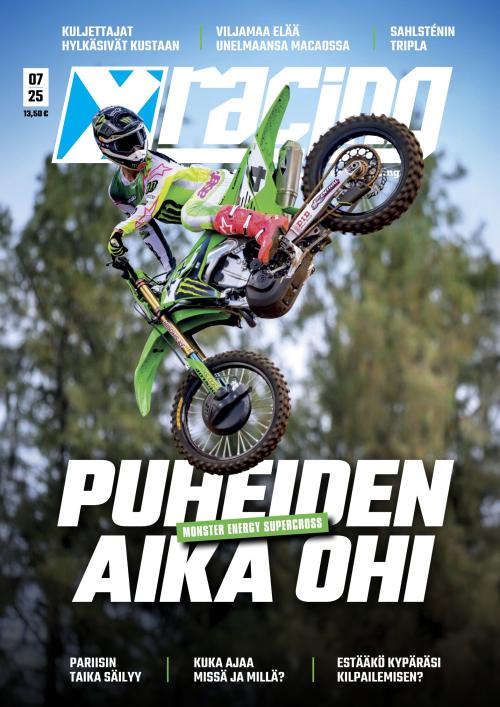Niksipirkka - keulaputkien linjaus
Kirjoittaja: TOM NORDMANAlla mainio dokumentti keulaputkien linjauksesta.
http://www.moto-pro.com/files/shoptips/front_axle_alignment.pdf
-----Clip---- Article By: John Minnich, President Moto Pro Suspension
Front Axle Alignment:
*This tip works on most front ends, KTM used in example.
Fork misalignment is the single most common chassis set up problem we see at Moto Pro when customers bring in bikes with suspected fork problems. Most KYB, Showa and WP forks are manufactured using the floating design so this example is valid for virtually all dirt bikes. Harshness and poor square edge bump absorption common with stock valving is further magnified by misalignment. When servicing forks, uneven bushing wear and striations on the chrome legs will be evident if the problem has been ongoing. Even the best ULTRA MAX equipped suspensions will
continue to operate below there potential if the forks are not properly aligned after being installed on the bike. The procedure outlined below should be performed every time the front wheel is reinstalled. Fork shift may also occur after a fall, especially when the force was sufficient to bend the bars or
require twisting the top clamp back into alignment. If you want to prepare the axle and axle bore like we do with our Moto Pro shop bikes, polish the inner
surface of the right leg axle bore with 800 grit wet/dry and lightly chamfer the edges. Using a lath or suitable polishing materials polish the right side of the axle where it mates with the right fork leg. These two steps will reduce the friction between the axle and fork leg making the alignment process
more accurate.
Step 1
Place the bike on a work stand so the front wheel is off the ground. If the forks have been removed for service reinstall both forks in the triple clamps and torque the fasteners to the recommended value in your service manual. Set the proper exposed height above the top of the triple clamp. Mount the axle with wheel and brake caliper etc and tighten the axle nut and caliper bolts to there proper values listed in your service manual (Image 1).
Step 2
Pump the front brake to restore the firm feel and tighten the pinch bolts on the brake side fork leg. The non brake side pinch bolts should still be loose. These bolts are easily broken so lube them with anti-seize and follow the torque recommended in your service manual.
Step 3
The non brake side (right side on most bikes) is designed to float on the Axle. On older models there may be a plate with 4 nuts. The clearance between the inner & outer bushings and the size of the axle through hole all contribute to the alignment problem. Proper alignment is achieved when the right leg is parallel to the left leg after all the bolts have been properly torqued. Begin by gently tapping a small screw driver into the pinch gap of the right fork leg (Image 2). Remember to loosen the bolts far enough to allow the gap to spread slightly. Observe what happens when you push the fork leg toward the wheel hub and release it. Now
pull the leg away from the hub and release it. You can clearly see the ability of the fork leg to move. This movement is what we use to properly align our forks. Notice a small zero point exists where the leg appears to have no tension on it. In other words you can move the fork along the axle without feeling any tension (Image 2). As accurately as possible hold the fork at the center of the zero point and tighten the pinch bolts. With the motorcycle on its tires apply the front brake and gently push down on the bars. The forks should feel smooth without
any sticking or binding. If the bike has been sitting for awhile, aggressively pump the suspension several times to lubricate the wipers and bushings, then perform the gentle compression. If you still feel a sticky response repeat the zero point procedure.
Some forks are not perfectly straight or the problem may lie with the machining of the triple clamps. Sometimes a bent front axle is the culprit. Use the floating right leg as your adjuster to make the forks as smooth as possible. The perfect location for your bike may not be in the middle of the zero point it may occur anywhere within the range of bushing play. Experiment with several settings before determining which one feels best. Remember to torque the right side pinch bolts properly after completing the alignment process.
Now you have the ability to keep your forks in perfect alignment. Do this procedure anytime you detect unusual harshness in the forks or the bike is crashed. The difference is noticeable and your suspension will perform at its maximum.
-----Clip Ends---- Article By: John Minnich, President Moto Pro Suspension
- Kirjaudu tai rekisteröidy kirjoittaaksesi kommentteja




If you enjoy fast-paced, endlessly rewarding tap games, Crazy Cattle 3D should be on your radar.